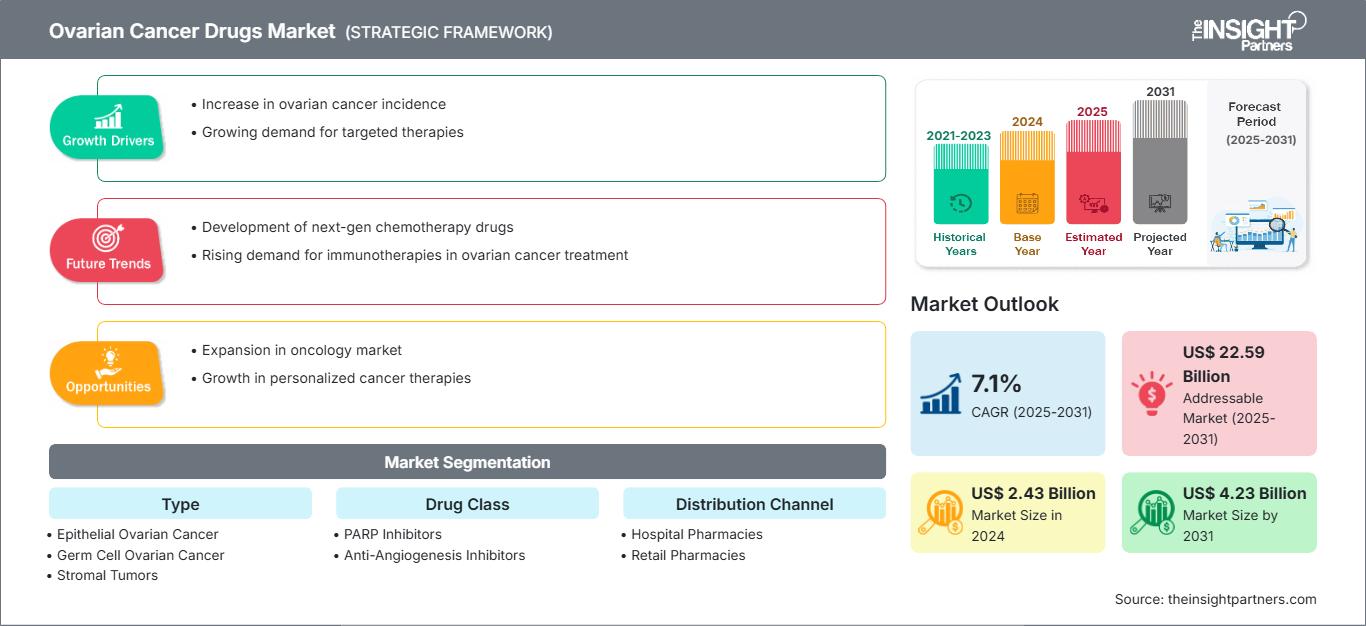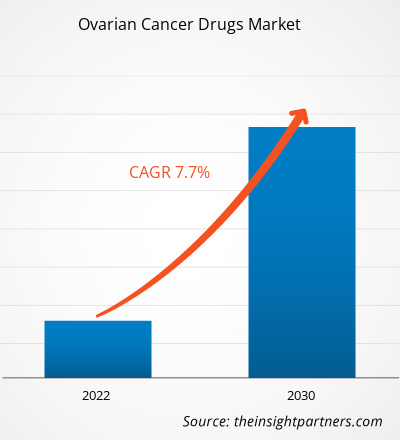Se prevé que el tamaño del mercado de medicamentos para el cáncer de ovario crezca de 2.430 millones de dólares en 2024 a 4.230 millones de dólares en 2031; se estima que el mercado registrará una tasa de crecimiento anual compuesta (TCAC) del 7,1% durante el período 2025-2031.
Perspectivas del mercado y opinión de los analistas:
El aumento de la incidencia del cáncer de ovario impulsa el crecimiento del mercado de fármacos para esta enfermedad. Sin embargo, las retiradas de productos del mercado debido a efectos adversos frenan dicho crecimiento.
Factores impulsores del crecimiento:
El aumento de la incidencia del cáncer de ovario impulsa la demanda de opciones terapéuticas.
El cáncer de ovario es el séptimo cáncer más común entre las mujeres y la tercera neoplasia ginecológica más frecuente, después del cáncer de cuello uterino y el cáncer de endometrio (útero), respectivamente. Según el informe de la Coalición Mundial contra el Cáncer de Ovario, cada año se diagnostican 324 000 casos de cáncer de ovario y 207 000 mujeres fallecen a causa de esta enfermedad. Además, la mayoría de las pacientes con cáncer de ovario reciben el diagnóstico en una etapa avanzada (localmente avanzada o metastásica), ya que no existe un programa de detección precoz de este tipo de cáncer en la población general. Por lo tanto, la creciente incidencia del cáncer de ovario impulsa la demanda de opciones terapéuticas eficaces. El tratamiento de primera línea, que combina cirugía citorreductora y quimioterapia basada en platino, es el estándar para las mujeres recién diagnosticadas con cáncer de ovario avanzado. Asimismo, opciones terapéuticas como los inhibidores de PARP aprobados, olaparib, rucaparib y niraparib, representan avances significativos en el tratamiento del cáncer de ovario recién diagnosticado. El uso de inhibidores de PARP en el tratamiento del cáncer de ovario avanzado se ha consolidado como una opción terapéutica eficaz para mejorar los resultados clínicos. Estos inhibidores proporcionan eficacia a largo plazo y supervivencia libre de progresión (SLP) en los casos recién diagnosticados, tras una respuesta completa (RC) a la primera, segunda y tercera quimioterapia basada en platino.
Obtendrá personalización gratuita de cualquier informe, incluyendo partes de este informe, análisis a nivel de país y paquetes de datos de Excel. Además, podrá aprovechar excelentes ofertas y descuentos para empresas emergentes y universidades.
Mercado de fármacos para el cáncer de ovario: Perspectivas estratégicas

-
Obtenga las principales tendencias clave del mercado de este informe.Esta muestra GRATUITA incluirá análisis de datos, que abarcarán desde tendencias de mercado hasta estimaciones y pronósticos.
Segmentación y alcance del informe:
El análisis del mercado de fármacos contra el cáncer de ovario se ha llevado a cabo considerando los siguientes segmentos: tipo, clase de fármaco y canal de distribución.
Análisis segmentario:
Por tipo, el mercado se segmenta en cáncer de ovario epitelial, cáncer de ovario de células germinales y tumores estromales. El segmento de cáncer de ovario epitelial ostentó la mayor cuota de mercado de fármacos contra el cáncer de ovario en 2022; se prevé que este mismo segmento registre la mayor tasa de crecimiento anual compuesto (TCAC) del 8,2 % durante el período de pronóstico. Según el informe de Cancer Research UK, el cáncer de ovario epitelial es el tipo más común de cáncer de ovario. Por ejemplo, casi 90 de cada 100 tumores de ovario (90 %) son tumores epiteliales. Las pacientes con cáncer de ovario agresivo en estadio avanzado tienen opciones de tratamiento limitadas disponibles en el mercado. En noviembre de 2022, la Administración de Alimentos y Medicamentos (FDA) anunció la aprobación de "mirvetuximab soravtansine-gynx", fabricado por Elahere ImmunoGen, Inc., para pacientes adultas con cáncer de ovario epitelial. La dosis recomendada por el médico para este fármaco en investigación para el tratamiento del cáncer de ovario epitelial es de 6 mg/kg, administrada una vez cada tres semanas mediante infusión intravenosa. En enero de 2024, la FDA anunció la aprobación de la designación de vía rápida (FTD) para "RC88", un conjugado anticuerpo-fármaco (ADC) dirigido a la mesotelina para el tratamiento de pacientes con cáncer de ovario epitelial recurrente. Por lo tanto, el creciente número de aprobaciones de fármacos está impulsando el mercado de medicamentos para el cáncer de ovario epitelial.
Tendencias del mercado de fármacos contra el cáncer de ovario
Terapia farmacológica combinada
Diversos institutos de investigación médica están desarrollando nuevos fármacos combinados para tratar el cáncer de ovario. En septiembre de 2023, investigadores del Royal Marsden anunciaron una nueva terapia combinada que ha demostrado ser eficaz en pacientes con cáncer de ovario avanzado. Los investigadores probaron esta terapia combinada para evaluar su efecto en el cáncer de ovario seroso de bajo grado (COSBG), una forma rara de cáncer de ovario con una baja tasa de respuesta a los tratamientos. El ensayo clínico RAMP-201 se llevó a cabo combinando avutometinib con defactinib para investigar su efecto terapéutico sinérgico en pacientes con COSBG. Los resultados preliminares del ensayo clínico revelan que el 45 % de las pacientes tratadas con la combinación de fármacos experimentaron una reducción significativa de sus tumores. Estos resultados clínicos tan satisfactorios con la terapia combinada son casi el doble de eficaces que trametinib, un fármaco de terapia dirigida disponible en Inglaterra con una tasa de respuesta de solo el 26 %. En enero de 2024, la FDA anunció la aprobación del fármaco combinado SH-105 para el tratamiento de pacientes con cáncer de mama y ovario. Por lo tanto, las terapias combinadas con fármacos están emergiendo como nuevas tendencias que probablemente impulsarán el crecimiento del mercado de medicamentos para el cáncer de ovario en los próximos años.
Análisis regional:
El alcance del informe sobre el mercado de fármacos para el cáncer de ovario abarca Norteamérica, Europa, Asia Pacífico, Sudamérica y Centroamérica, y Oriente Medio y África. En 2022, Norteamérica ostentó la mayor cuota de mercado. El crecimiento del mercado en esta región se debe al creciente número de lanzamientos de productos por parte de las principales compañías y a la presencia de actores clave. Estados Unidos es el principal contribuyente al mercado norteamericano. La creciente incidencia de cáncer de ovario en mujeres impulsa a las compañías y a los organismos reguladores a desarrollar y aprobar, respectivamente, fármacos innovadores en esta región. Asimismo, el creciente número de organizaciones de investigación clínica por contrato (CRO) favorece el crecimiento del mercado de fármacos para el cáncer de ovario en Norteamérica.
Perspectivas regionales del mercado de fármacos contra el cáncer de ovario
Los analistas de The Insight Partners han explicado en detalle las tendencias regionales y los factores que influyen en el mercado de fármacos contra el cáncer de ovario durante el período de previsión. Esta sección también analiza los segmentos y la geografía del mercado de fármacos contra el cáncer de ovario en Norteamérica, Europa, Asia Pacífico, Oriente Medio y África, y Sudamérica y Centroamérica.
Alcance del informe sobre el mercado de fármacos contra el cáncer de ovario
| Atributo del informe | Detalles |
|---|---|
| Tamaño del mercado en 2024 | US$ 2.430 millones |
| Tamaño del mercado en 2031 | 4.230 millones de dólares estadounidenses |
| Tasa de crecimiento anual compuesto global (2025 - 2031) | 7,1% |
| Datos históricos | 2021-2023 |
| Período de pronóstico | 2025-2031 |
| Segmentos cubiertos |
Por tipo
|
| Regiones y países cubiertos |
América del norte
|
| Líderes del mercado y perfiles de empresas clave |
|
Densidad de los actores del mercado de fármacos contra el cáncer de ovario: comprensión de su impacto en la dinámica empresarial
El mercado de fármacos para el cáncer de ovario está creciendo rápidamente, impulsado por la creciente demanda de los usuarios finales debido a factores como la evolución de las preferencias de los consumidores, los avances tecnológicos y una mayor concienciación sobre los beneficios del producto. A medida que aumenta la demanda, las empresas amplían su oferta, innovan para satisfacer las necesidades de los consumidores y aprovechan las nuevas tendencias, lo que impulsa aún más el crecimiento del mercado.

- Obtenga una visión general de los principales actores del mercado de fármacos contra el cáncer de ovario.
Desarrollos de la industria y oportunidades futuras:
Las previsiones del mercado de fármacos contra el cáncer de ovario pueden ayudar a las partes interesadas en este mercado a planificar sus estrategias de crecimiento. A continuación se enumeran algunos avances estratégicos de los principales actores que operan en el mercado:
- En noviembre de 2022, ImmunoGen obtuvo la aprobación de la FDA para ELAHERE (mirvetuximab soravtansine-gynx) para el tratamiento de pacientes adultas con cáncer de ovario epitelial resistente al platino. ELAHERE está específicamente aprobado para pacientes con cáncer de ovario resistente al platino FRα positivo, una enfermedad compleja debido a las limitadas opciones de tratamiento y los deficientes resultados clínicos de las terapias existentes.
Panorama competitivo y empresas clave:
Elli Lilly, AstraZeneca, GSK, Zielab, ImmunoGen (AbbVie), GeneTech (Roche), Vivesto, Allarity Therapeutics, Inc., Aeterna Zentaris y Luye Pharma figuran entre las empresas más destacadas analizadas en el informe sobre el mercado de fármacos contra el cáncer de ovario. Estas empresas se centran en el desarrollo de nuevas tecnologías, la mejora de los productos existentes y la expansión de su presencia geográfica para satisfacer la creciente demanda mundial.
- Análisis histórico (2 años), año base, pronóstico (7 años) con CAGR
- Análisis PEST y FODA
- Tamaño del mercado, valor/volumen: global, regional y nacional
- Industria y panorama competitivo
- Conjunto de datos de Excel
Informes recientes
Informes relacionados
Testimonios
Razón para comprar
- Toma de decisiones informada
- Comprensión de la dinámica del mercado
- Análisis competitivo
- Información sobre clientes
- Pronósticos del mercado
- Mitigación de riesgos
- Planificación estratégica
- Justificación de la inversión
- Identificación de mercados emergentes
- Mejora de las estrategias de marketing
- Impulso de la eficiencia operativa
- Alineación con las tendencias regulatorias






















 Obtenga una muestra gratuita para - Mercado de medicamentos contra el cáncer de ovario
Obtenga una muestra gratuita para - Mercado de medicamentos contra el cáncer de ovario